Texas Railroad History - Tower 147 (Lantana) and Tower
151 (Rosita)
Two Crossings of the San Antonio &
Aransas Pass Railway and the San Benito & Rio Grande Valley Railroad near San Benito
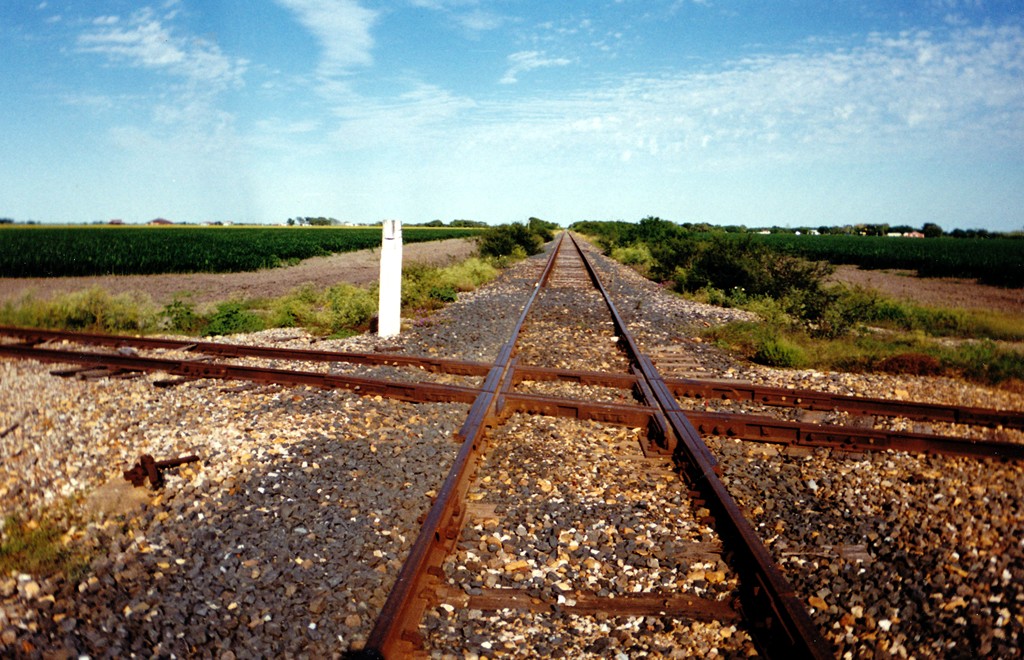 |
Left: This April, 1999 photo
taken by Randy Curlin at the Tower 147 crossing is looking east on the
Southern Pacific (SP) line toward Brownsville. The Missouri Pacific (MP)
Rio Hondo branch ran from San Benito (right) to Rio Hondo (left) and was
abandoned shortly after this photo was taken. The white gatepost is evidence
of the swing gate that protected the crossing in the 1970s. Originally, home and distant signals for both rail
lines were controlled by a cabin interlocker, a trackside hut that
housed the interlocking plant and its controls to be operated by train crews.
The signals were always set to allow
unrestricted movements on the SP line. MP crews would change them
temporarily as needed for their
train to cross the diamond.
By the time of this photo, the cabin
interlocker had been removed and the crossing was uncontrolled; all trains
were required to stop. Trains moved slowly (and infrequently) on these
tracks anyway, so the delay incurred by stopping at the crossing was
insignificant, certainly worth the cost of otherwise maintaining a cabin
interlocking and
multiple signals.
In 1982, MP was acquired by Union Pacific (UP)
and SP was similarly acquired in a 1996 merger. In 1997, UP fully merged
both railroads and began operating solely under the UP name, hence UP
was operating both lines in this 1999 photo.
|
In June, 1903, the St. Louis, Brownsville & Mexico
(SLB&M) Railway was chartered to build a line between the Lower Rio
Grande Valley and Houston, planning to establish the Valley's initial connection to the
national rail network. The SLB&M was the first of the Gulf Coast Lines (GCL),
the marketing name for a rail syndicate established by the St. Louis Trust
Company that was managed by the St. Louis & San Francisco ("Frisco") Railway.
The Frisco's Chairman, B. F. Yoakum, was a native Texan with substantial experience
in Texas
railroading. It was his idea to create the GCL under which he would build or buy railroads and
weave them into a system to compete directly with Southern Pacific (SP)
along the Gulf coasts of Texas and Louisiana.
To lead the SLB&M, Yoakum installed his former boss, Uriah Lott, as
President. Lott had been the founder, promoter and President of the San Antonio & Aransas Pass (SA&AP)
Railway, and
he had hired Yoakum in 1886 to be the SA&AP's traffic manager. Yoakum had risen into
SA&AP's senior executive ranks, becoming General Manager in 1889. By then, the
SA&AP
owned lines serving San Antonio,
Corpus Christi,
Houston, Waco,
Kerrville and numerous towns in between. When the SA&AP overextended its network
and couldn't pay its construction company, it was forced into receivership in 1890.
Lott lost his job, but Yoakum was appointed by the bankruptcy judge to be one of the two Receivers. The bankruptcy ended two years later when the SA&AP's
bondholders committee agreed to a plan that involved assistance from SP.
SP did
not serve south Texas, so it wanted a healthy SA&AP to supply
traffic at points along SP's east / west main line, e.g. San Antonio,
Flatonia and Eagle Lake. SP
could not legally purchase the SA&AP as that would run afoul of Texas' railroad
competition laws. Instead, SP was allowed to guarantee the interest on SA&AP
construction bonds as a means of helping to terminate the receivership. Although
state law prevented SP
from having any control over the SA&AP, the bankruptcy court
allowed 80% of SA&AP's stock to be acquired by the Pacific Improvement Company
(PIC), a holding company that owned
SP and various other assets, mostly real estate. Mifflin
Kenedy, owner of 20% of SA&AP's stock, agreed to
the plan, and the recently created (1891) Railroad Commission of Texas (RCT) did not
object. The new SA&AP ownership promptly filled the
management ranks of the reorganized company with numerous "SP men", suggesting that SA&AP would not be
truly independent.
Yoakum moved on, taking an executive position with the
Gulf, Colorado & Santa Fe (GC&SF) Railway and then becoming
General Manager of the Frisco in 1897. By early 1903, Yoakum's plans for a
Valley rail line to Houston were known, causing SP to "encourage" construction
of a competing line to the Valley from SA&AP's nearest service
point, the town of Alice. SA&AP commenced construction out of
Alice in September, 1903 toward Edinburg shortly
after the
SLB&M had begun building south out of Robstown toward
Brownsville. By June, 1904, the SA&AP
had completed 36 miles to Falfurrias, and a month later, the SLB&M finished
the 142
miles from Robstown to Brownsville. Technically, the SLB&M won the race to
provide the Valley with access to the national rail network because Robstown had
connections to both Alice and Corpus Christi via the Texas Mexican Railway. From
those towns, SA&AP had tracks to San Antonio. As the SLB&M prepared to build
200 miles north
from Robstown
to Houston, the Valley was only 67 miles from Falfurrias of which SA&AP had already graded the first ten
miles. But then...SA&AP's construction stopped.
The work stopped
because a year earlier, RCT had accused SP of illegal ownership of the SA&AP.
The smoking gun was an SP asset report to the Kentucky Railroad Commission (KRC)
which listed its ownership of SA&AP stock. [SP management assumed -- but could
not prove -- that Yoakum had somehow gotten wind of the report to KRC but did
not tip off RCT until it was to his advantage; the timing for Yoakum couldn't
have been better.] A
public hearing was held by RCT on April 27, 1903 during which SP and SA&AP
attorneys admitted that SP had possession of the stock originally held by PIC. A
settlement with RCT in the summer of 1903 allowed the SA&AP to avoid forfeiting
its Texas railroad charter in exchange for cancelation of the SA&AP stock held
by SP (with a corresponding reduction in the SA&AP's authorized capitalization
from $5 million to $1 million.) SP was also prohibited from guaranteeing
interest on any new SA&AP bond issues, but had to continue to back bonds already sold.
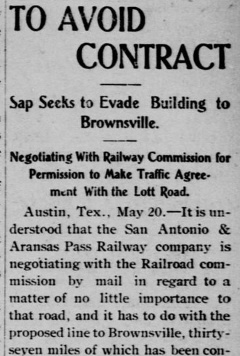 |
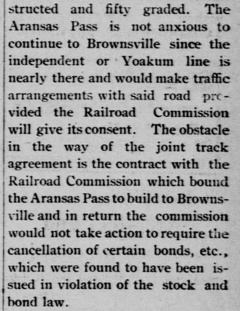 |
RCT's settlement with SP and SA&AP removed all traces
of SP ownership, leaving Mifflin Kenedy's heirs as the new owners. SA&AP
construction from Alice toward Edinburg began in September, 1903, but it was
doubtful that SA&AP would
be able to complete the effort with its existing capital. RCT
subsequently allowed SA&AP to sell SP-backed
bonds that had already been issued in exchange for SA&AP's agreement to build beyond Edinburg to
Brownsville. Nevertheless, SA&AP's work halted at Falfurrias in June,
1904.
In his reference tome,
A History of the Texas Railroads (St. Clair
Publishing, 1941), S. G. Reed (who began
his railroad career as a traffic manager for SA&AP in
Victoria) explained the
prevailing theory of why SA&AP's extension to the Valley ended abruptly:
"The project was dropped, in
June, 1904, for lack of funds and also to quiet the Railroad Commission. The
reason officially assigned for discontinuing work was that there was not enough
traffic in the Valley to support two lines, but another reason was surmised and
may have been controlling, which was that [E. H.] Harriman, who then controlled
the S. P., and Yoakum had effected a mutually satisfactory agreement for
preferential routing of traffic between their respective systems. It is known
that some such agreement was effected about that time and it continued for many
years, but that it involved the abandonment by the S. A. & A. P. of the Valley
extension is only a surmise."
Left: SA&AP's interest in
building to Brownsville was waning with the
"Yoakum line...nearly there." RCT eventually relented and allowed SA&AP to defer
construction to Brownsville. (Brownsville Daily
Herald, May 24, 1904) |
With SA&AP's line to the Valley stopped at
Falfurrias, the SLB&M completed its northward construction as far as
Algoa, 25 miles south of Houston, in 1906. Algoa was
on Santa Fe's main line between Galveston
and Temple, and a nearby Santa Fe branch
from Alvin served downtown Houston. The
Galveston Tribune of March 12, 1906
reported that the first SLB&M train to Galveston from Brownsville would
be arriving later that day. This was, however, a one time special train, not the start of
regular service. The SLB&M had already determined that the grade,
ballast and bridge construction between Bay
City and Algoa -- a sixty-mile stretch through the Brazos River
bottomlands -- was insufficiently engineered to withstand the rainy
season. Significant drainage mitigation and track reconstruction
projects had to be undertaken. Another special excursion train ran from
Brownsville to Galveston on August 14, 1907, seventeen months after the
first one (it had been so long that newspapers reported it as "the first
train", completely forgetting the earlier one!)
The August excurion was a precursor to regular service between Brownsville and Algoa.
On September 9, 1907, the SLB&M announced a regular schedule between Bay
City and Algoa, indicating that the track construction and drainage
problems had been solved. The schedule was subsequently revised out of
Brownsville to match the Bay City schedule, enabling single train
service between Brownsville and Algoa. Passengers continued their
journey by switching to (or from) Santa Fe trains at Algoa. About six months later, Yoakum was able to negotiate rights
for the SLB&M to
use Santa Fe's tracks from Algoa to Houston.
Right: The
Brownsville Daily Herald of April
13, 1908 reported that the SLB&M's Brownsville - Houston
passenger service would commence on April 19. |
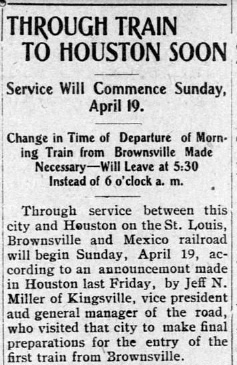 |
Twenty-five miles north of Brownsville, the SLB&M had
collected a bonus in 1904 for building through a landholding where the town of
Harlingen was founded. The SLB&M immediately began
building a lengthy branch line out of Harlingen, eventually reaching Rio Grande
City in 1906, 73 miles west. In 1910, another syndicate backed by the Frisco
began construction on secondary lines in the
Valley. Two years later, the San Benito & Rio Grande Valley (SB&RGV) Railway was
chartered by Frisco interests to take over this work and finish the construction.
SB&RGV operations began in two separate service areas in 1912, reported to
RCT as a total of 62.1 miles of track. One area
was in the vicinity of the town of Mission; the other was a combined 30 miles of tracks in
opposite directions from San Benito
leading to Santa Maria to the southwest, and Rio Hondo to the northeast.
SLB&M provided connections for the SB&RGV at Mission and San Benito. The SB&RGV was
effectively a lower cost branch line operator for the SLB&M.
In 1910,
the Frisco bought the GCL railroads from the St. Louis Trust Co. They were
profitable, and the Frisco likely expected that direct ownership and embedded
Frisco management would improve its traffic flow between the Valley and the
Midwest. Perhaps so, but on
May 27, 1913, the Frisco went into receivership. The bankruptcy judge separated
the GCL railroads and arranged for an existing GCL railroad, the New Orleans, Texas & Mexico (NOT&M) Railroad,
to be re-chartered by the State of Louisiana so that it could become the new,
independent parent company for the GCL
railroads. The SB&RGV had not been a
GCL railroad, but it was acquired by the NOT&M in 1916 and continued its role
as a branch line operator for the SLB&M.
On January 1, 1925, Missouri Pacific
(MP) bought the NOT&M, having gained permission from the Interstate Commerce
Commission (ICC.) The ICC had supplanted RCT's control over Texas railroad mergers
and acquisitions when the Federal Transportation Act of 1920 took effect. The NOT&M
had recently acquired the International -
Great Northern Railroad in 1924 which had a large presence across Texas, including
a line through San Antonio to Laredo. SP reacted to MP's sudden and substantial
competitive posture in south Texas by
quickly seeking to re-acquire the SA&AP. Permission from the ICC was
granted, and as an SP subsidiary, the SA&AP restarted construction south from Falfurrias on July 30, 1926.
This led to an immediate flurry of railroad construction in the Rio Grande
Valley.
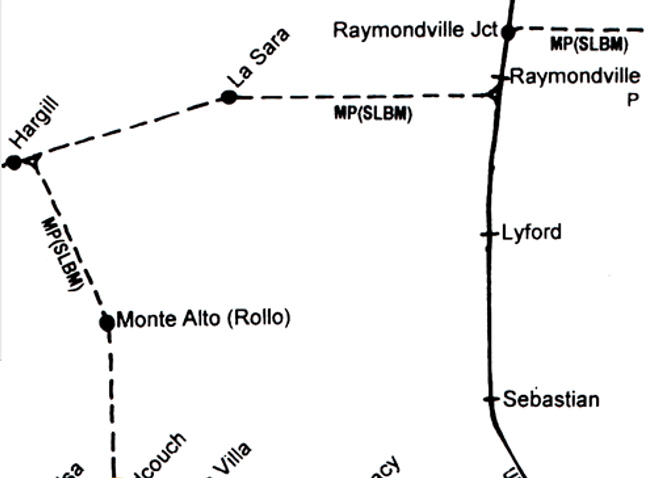 |
Left and Below:
This image is a snippet of a larger map published by Mike Walker ((c)
SPV, 2001.) The former SLB&M main line comes south from Robstown through Harlingen
to Brownsville. It is still intact, as is the ex-SA&AP
branch between Harlingen and Brownsville. Despite the map's solid line, the San Benito - Rio Hondo branch
had been removed in 1999. Map
annotations show area
interlockers; two are off the map at Edinburg
(Towers 145 and 149.)
In response to SP restarting construction to
the Valley, MP preemptively built an SLB&M branch line west from Raymondville in 1926.
One objective was to reach areas in and around Edinburg before the SA&AP
arrived. The branch went through Hargill and
Faysville to Monte Christo, and there were additional branches from Hargill to
Edcouch and
from Faysville to Edinburg. SA&AP rails reached
Edinburg in early 1927 and the SA&AP immediately built a 63-mile branch line
east to Brownsville. The Brownsville branch crossed the SLB&M main line at Harlingen
and also crossed the SB&RGV's Rio Hondo branch near Lantana. With the
SA&AP entering Brownsville, MP countered with a 19-mile SB&RGV branch
east from San Benito to Abney in 1928 (extended to Port Isabel in 1941.)
This branch crossed the SA&AP east of Laureles and north of
Los Fresnos, a location RCT recorded as "Rosita."
The
first interlocked crossing in the Valley was at Tower 138 (green circle), a
2-story manned tower where the SA&AP built across the SLB&M at
Harlingen. It was commissioned on September 10, 1928. The last to be
commissioned was Tower 151 (blue circle) on April 17, 1929 where the
SB&RGV built across SA&AP's Brownsville branch. It was officially
located at Rosita, a name used in SP's interlocker documentation. The
map has locations called Laureles and Gray Bill nearby, but it does not
show Rosita in the vicinity (nor anywhere else.) A 1932 MP timetable
says that "Graybill" was 0.4 miles east of the crossing and Laureles was
0.8 miles west. SP timetables from the 1940s confirm the crossing near Laureles
to be the site of Tower 151. |

According to RCT records, Tower 147 and Tower 151 were both
commissioned as 11-function mechanical cabin interlockers (and both in 1929,
on March 13 and April 17, respectively.) From SP documentation for similar
cabins, it is likely that these eleven
functions consisted of four derails, four home signals, one door lock
and two distant
signals on the SA&AP, one in each direction to warn approaching trains
if the crossing was occupied. The SB&RGV tracks did not need distant signals because SB&RGV trains always stopped at the diamond before
crossing.
Right:
This image is a very high magnification of the Tower 146 cabin at
Edcouch as it appears in the distant background of a much larger photo
taken between 1958 and 1968 (Bill Bentsen collection.) Among the cabin
interlockers in the Valley, this is the only one for which an image has
been found. It was designed and built by SP, so it is very likely
representative of the appearance of the cabins at Tower 147 and Tower
151. |
 |
Through the end of 1930, RCT published an annual list
of active interlockers. For each interlocker, the list included the railroads
involved, the type of interlocking
plant, the function
count and the location. For all Lower Rio Grande Valley interlockers,
the SA&AP and the SLB&M were listed as the railroads involved,
even though Tower 147 and Tower 151 were on
SB&RGV rail lines. The SLB&M was substantially larger and may have provided the
rolling stock for operations on the SB&RGV. In 1956, as MP was being reorganized
out of a lengthy bankruptcy, its various NOT&M railroads became fully merged and
ceased to exist as separate entities as of March 1 of that year.
 |
Left:
(Carl Codney collection, with inset from
Railway Signaling, October, 1944) A "D-205" drawing
was used by SP to
summarize the
...LEVERS, FUNCTIONS AND DIVISION
OF EXPENSE AT INTERLOCKING PLANT for each tower where SP
had a financial interest. This one for Tower 151 locates it "...at or
near Rosita, Texas." Why SP used this name is
unknown, and no non-railroad historical use of "Rosita" in this vicinity has been found. The
DATE of November 8, 1928
was about five months before
the interlocker was approved for service by RCT. From
the REMARKS column, it is known that the plant
design was released March 20,
1928. This was during a nine day span in which the interlockers for
Tower 146 and Tower 149 were also designed (and perhaps Towers 138, 145 and
147 as well,
but those D-205 records haven't been located.)
This D-205 drawing is a revision to the original because it was "Revised effective Aug 1 -
1944 account T&NO derails 4 & 8 abandoned" (note inset from
Railway Signailing, October,
1944 reporting this news.) The change resulted in a new expense split of
50 / 50 based on the function count. The "Void" scrawl indicates that
there is a later version that became the master document. The last known
version records a change dated December 1, 1955 when approach signals
were made inoperative on the SB&RGV. As those signals don't appear on
the document at left, they must have been added with yet another
revision later than this one that
preceded the final version. Instead of "Void", the final document has
a hand-written note across it... "Out of service 7-1-69."
The decommissioning of Tower 151 can be attributed to MP's
abandonment of the SB&RGV line to Port Isabel in 1969. The
document notes that the interlocker is OPERATED BY "SB&RGV
Trainmen", i.e. having stopped at the diamond, an SB&RGV crewmember would
enter the cabin to set the controls to permit his train
to cross. Once the train was safely across, he would reset the
controls for unimpeded operation by the SA&AP. The document also says that the interlocker was
MAINTAINED BY
"SA&AP Ry". There was no definitive rule as to which railroad
would handle maintenance for a cabin interlocker, but it was common for
the busier railroad to take the maintenance responsibility.
The image
below is from a 1932 MP employee
timetable. It describes the cabin interlockers in south Texas as being
"with T&NO", the Texas & New Orleans Railroad, SP's principal operating
railroad in Texas which leased the SA&AP and most other SP railroads in
Texas in 1927. The cabin interlockers listed "will be handled by trainmen", i.e.
crew members of trains covered by this timetable. Thus, T&NO trains would normally proceed unimpeded
through each interlocker unless the signals indicated that the diamond
was occupied by an MP (SLB&M or SB&RGV) train. In the order presented below,
the crossing references are Tower 145,
Tower 146, Tower 149, Tower
147 and Tower 151.
 |
The surprising element to SP's D-205 document for Tower
151 is that the SB&RGV is listed as SENIOR COMPANY even though RCT
construction records state that the SB&RGV tracks were laid in 1928,
a year
after the SA&AP's tracks. By
construction date, the SA&AP should have been the senior company. Under state
law, the senior company was not required to share the capital outlay for
installing an interlocker at a new crossing (i.e. created after the interlocker law became
effective in 1901.) For crossings that existed prior to 1901, the capital
expense was split equally among the railroads involved. Recurring costs for staffing (manned towers) and maintenance were
shared based on the percentage of assigned interlocker functions. Listing the
SB&RGV as the SENIOR COMPANY for Tower 151 implies that SP funded the design and installation of Tower 151
even though its tracks were there first.
The best conjecture for this is that SP and MP swapped tower construction projects.
This identical scenario was reversed at Tower 149 where the
SA&AP arrived after the SLB&M yet the SA&AP
is listed as the SENIOR COMPANY in the D-205 for Tower 149, imnplying that MP
had the funding and construction responsibility.
Why
swap projects? The answer is undetermined, but the
SB&RGV was the senior company at
Tower 147, about 10 rail miles northwest of Tower 151. Thus, SP was responsible
for funding Tower 147. As the Tower 147 and Tower 151
interlockers were 11-function mechanical cabins within ten
miles of each other
involving the same railroads and the same operational scenario (signals normally
lined for SA&AP operation), SP may have decided it could design and build Tower 151 simultaneously
with Tower 147 at a savings compared to the cost of designing and building Tower 149,
which was more than 45 rail miles from Tower 147. Why
would MP consent to swapping projects? The SB&RGV was a small railroad with
a limited engineering staff that had never been involved with an interlocker.
Since the SB&RGV would have needed to call upon MP's engineering staff
for the
effort, MP may have preferred (or at least been willing) to swap with SP and
fund Tower
149 instead of Tower 151.
 |
Left: In 1970, the Tower 147 crossing still had
the interlocker cabin sitting in the northwest quadrant casting a shadow
to the north.
Right:
In 1983, the tracks remained in place but the cabin was no longer
present.
Both images (c) historicaerials.com |
 |
Right: Randy
Curlin took this
April, 1999 photo from the southwest quadrant of Tower 147 looking northeast along
the MP tracks toward Rio Hondo. It shows MP's homemade stop sign with the SP line
crossing in the background. Note the white gatepost also visible in the image at
top of page.
Randy's observations of Tower 147:
"The
Lantana location was extremely obscure
and I doubt that many photos exist. It was the location of the MP Rio
Hondo Branch running from San Benito to Rio Hondo crossing the SP line
to Brownsville. SP movements had priority. It was protected by a
swinging gate (from 1970s MP timetables) then later homemade stop signs
(1990s). The branch was sold to the Rio Valley Switching Co to serve a
remaining petrochemical firm around 1997. By 1998 the firm stopped
shipping by rail and the line was abandoned and removed in 1999."
SP abandoned the former SA&AP main line south to Edinburg in 1979 and
began sharing MP's former SLB&M main line to the Valley. In 1982, Union
Pacific (UP) acquired MP, and in 1996, UP also acquired SP. By then,
SP's former SA&AP branch from Harlingen to Brownsville was the major
component of what was left of SP in the Valley. It remains in service as
of 2025. |
 |

Above: This 1955 USGS
Topographic map shows the Tower 151 crossing near the center of the image. Below:
Historic aerial
imagery was used to identify geographic coordinates that were then mapped onto a Google Maps satellite image.
The result is this annotated map showing the MP right-of-way and the location of the
Tower 151 crossing. The MP tracks were removed in 1969 and the housing subdivision did not develop until after 1980 by
which time the former MP grade had been obliterated by farming and other
land uses. There is no longer any sign of the MP grade in this area. The SP
tracks (now owned by UP) remain operational.



Above Left: This 1953
image ((c)historicaerials.com) shows that the Tower 151 cabin sat in the
northeast quadrant of the diamond. The bright spot to the north on the other
side of the SP tracks appears to have been an equipment cabinet. Its smaller
shadow suggests it was lower in height than the interlocking cabin.
Above Right: The view looking
east from Denise Road along the former MP right-of-way shows no
sign of the grade. Delta Drive is the roadway to the left. Since the analysis
above shows the grade passing north (left) of the nearby house, the red vehicle parked
in the driveway would appear to be straddling the invisible MP tracks.















